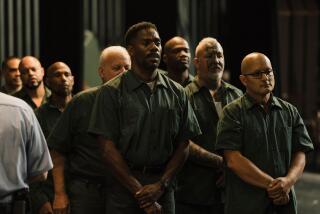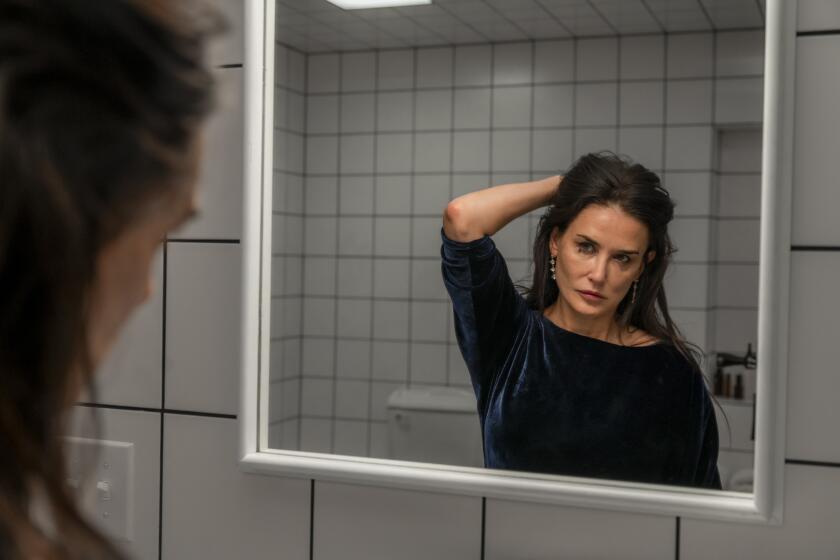A Filmmaker Goes Underground to Find Compelling Story
Noel Coward once famously wrote that only “Mad dogs and Englishmen go out in the midday sun.” So maybe it’s not surprising that it’s an Englishman sitting across the table from me at a coffee shop cheerfully saying, “I loved it down there. Absolutely loved it.”
The contemporary Englishman is Marc Singer, a slight, fashionably shaven-headed 27-year-old and “down there” is a railroad tunnel that runs underneath the West Side of Manhattan, which was home to a group of vagrants until they were removed by Amtrak officials.
For more than a year, Singer lived with them, sharing their meals and toilet facilities (i.e., a bucket) and employing them as a camera crew for his stunning black-and-white documentary about the tunnel, “Dark Days,” a multiple award winner at this year’s Sundance Film Festival.
It’s hard to convey the surreal nature of this film. The tunnel--huge, overarching, and, of course, pitch black--is like a parallel universe, the stuff of apocalyptic science-fiction stories. Its inhabitants, ignored to the point of invisibility on the streets above, established a society of sorts below, constructing a shantytown out of New York’s detritus. They tapped the city’s power grid for electricity and siphoned off its water. For food and clothing they rummaged through the city’s garbage.
They had myriad reasons for being down there. One of them “goes nuts,” as Singer puts it, and jumps in front of a train. Another reveals that she lost her children in a fire. Yet another says that his daughter was raped and mutilated while he was in jail. Crack smoking is endemic in the tunnel, as are rats. It’s dank, and freezing in the winter.
Yet to a man (and woman) they say that living in the tunnel is preferable to the city’s streets and homeless shelters. All in all, the viewer is initially fascinated by their plight, then repelled and finally sympathetic.
“One of the things I tried to do with the film was have the audience almost go through what I went through,” Singer says. “When you first go into the tunnel, you look at the houses and stuff, you’re quite impressed with what they’ve done for themselves, or I was. And then when you start seeing the first stages of the drugs, the way Clarence and Dee [two of the tunnel dwellers] are smoking, you kind of go ‘Wow,’ and then throughout the film they win you over again.”
In a way, Singer was at home down there. “I felt more accepted for what I am in the tunnel than I ever felt in any place in my entire life,” he says.
Singer was--and, in some cases, still is--estranged from England, many members of his family (he hasn’t seen his mother since he was 12), and from himself. Involved with drugs and England’s rave scene, he moved to the United States when he was 17, joining a friend who lived in Florida.
At 20 he moved to New York where he did some modeling, and became interested in the city’s homeless and that eventually led him down into the tunnel.
Initially, Singer went down there out of curiosity, and to help. Among those he bonded with was Ralph, who suggested that he should document what he was seeing on film. He could use the people living there as the crew and split with them whatever money it would make. A great subject, a worthy cause, only Singer knew nothing about filmmaking. He even had to be taught how to load a camera, which makes his Sundance award for cinematography even more amazing.
Yet somehow the film got made. For electricity, they hot-wired cables overhead. For a dolly track, they used abandoned railroad tracks. Henry, the guy shown on screen cooking cornbread, became the production’s electrician and first assistant director. Singer secured financing from friends and from a producer he met in a bar.
“I wanted to be homeless so badly,” Singer says. “I wanted to know what it felt like, which is another reason that I wanted them to be the crew, and that was because I’m not homeless.”
Altogether, Singer shot about 50 hours of footage. For the most part he felt very little of the pressure to capture magical moments that plague most documentarians, because “Dark Days” is primarily a record of the tunnel denizens’ daily existence--a look at their Rube Goldberg domestic arrangements, surprisingly palatable meals, and endless chat, which is by turns rueful, horrifying, and addled. In a memorable sequence that one reviewer compared to something out of Samuel Becket, Ralph and Dee engage in a hilariously pointless and picayune argument over a coffee cup, a dispute that Singer says lasted for two weeks.
Preparing for the Eviction
The one event that Singer needed to be on top of was the eventual eviction of the tunnel people--about 45 in all--some of whom had been living there for more than 20 years. He spent eight months trying to help make their transition to the world upstairs an easy one, getting them IDs, supporting their drug rehab, cutting through red tape, so that they would qualify for housing that the city miraculously had on hand.
Captured on film is the strange sight of one man knocking down the walls of his hovel with a mixture of anger and glee. Following that is a brief tour of Ralph’s clean, airy--and sunny--apartment. Under the circumstances, it’s almost as surreal as the tunnel.
And what about Singer? “When they got out of the tunnel and into their apartments, that’s about the time when it really hit the fan for me,” he says. “About 15 months of not touching the film, the money just wasn’t there, and it was a full-time job of just making it each day.”
Now, with the triumphs at Sundance, he’s got encouragement and validation, if not money. He loves America. He says it with a passion that’s both infectious and refreshing. It’s changed him, for the better, he declares.
Then he adds, with what must be the same cockeyed optimism that produced “Dark Days,” “Everyone I’ve talked to says, ‘When you finish this, you’re going to be bummed out because that’s all you’ve done.’ But I have enough ideas to keep me busy for a long time. Inventions. I love inventions. Got loads of them. That’s what I hope is going to get me out of the hole, maybe a couple of inventions.”
More to Read
Only good movies
Get the Indie Focus newsletter, Mark Olsen's weekly guide to the world of cinema.
You may occasionally receive promotional content from the Los Angeles Times.










